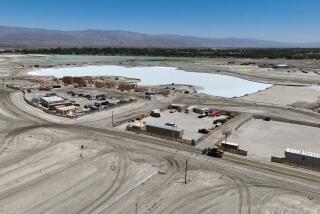Little Benefit Seen for Parks in Growth Plan
- Share via
Rancho Mission Viejo’s plan for massive development of pristine land in south Orange County would add only 1,600 acres to existing public parks, far less than anticipated, parks officials said Friday.
Instead, the company would keep control of much of the 14,000 acres it is pledging to preserve.
“I’m rather disappointed,” said Eric Jessen, chief of acquisition and development for the county Department of Harbors, Beaches and Parks.
“We’ve made it clear to them for years what we were looking for. I saw very little of it in what they presented.”
He and others anticipated that the O’Neill family, which has owned the property since 1882, would deed over thousands of acres to parks on its borders.
Putting the land in the county’s hands would not only guarantee public access, they said, it would keep the open space in large contiguous blocks, the best scenario for endangered habitat.
Rancho Mission Viejo leaders are taking a different view. They say they too are disappointed that after donating 3,750 acres of parkland to the county in 1982, more than half of that land is off limits to the public in Caspers Wilderness Park.
“The reality is, public ownership does not automatically mean public access and benefits,” company spokeswoman Diane Gaynor said. “And private ownership does not preclude public access.”
About 15% of Caspers is restricted because it is habitat for a number of rare species, including the endangered California gnatcatcher and arroyo toad.
The company’s proposal would add about 400 acres to O’Neill Regional Park and create a 1,200-acre public park near the flood plain along Ortega Highway.
Through four decades in the development business, the family-owned company has deeded several thousand acres to the public parks system.
Now it is preparing to build on the 25,000 acres that remain of a 120-year-old ranch that once stretched from El Toro to Oceanside.
“They gave no indication of adding any land to two of our most sensitive and resource-rich wilderness parks, Caspers and Riley,” Jessen said.
Because the land between Caspers and Thomas Riley Wilderness Park is a habitat for mountain lions, the county was hoping to add it to those areas, Jessen said.
Rancho Mission Viejo’s preliminary plan shows that acreage as open space under company management. The parcel is home to several endangered plants and animals.
“We’re talking about some privately managed preserves with conservation easements that ensure they can never be developed,” Gaynor said.
Jessen and other preservationists disagreed.
“I don’t think that land is as safe under private ownership,” said Elisabeth Brown, president of Laguna Greenbelt Inc., a local preservationist group. A conservation easement--a deed restriction that prohibits development--would not be enough insurance if the conservancy should go bankrupt, she said.
“Where is the certainty that it will continue to be open space in the future? It’s not like setting up a national park and knowing it will be protected.”
Brown said much of a 10,000-acre parcel that the company proposes as open space would be used for ranching and farming.
“That’s not open space,” she said. “That’s like calling a golf course open space. When you have cattle grazing on the property you are changing the ecological mix.”
Some environmentalists are angry that Rancho Mission Viejo unveiled a development plan at all.
The proposal it presented Thursday would build a series of villages with a total of 14,000 homes extending from San Juan Capistrano to the Cleveland National Forest, the last major swath of privately owned open space in South Orange County.
Because company officials agreed years ago to develop the land under federal programs that bring environmentalists, government agencies and the landowner together in crafting a plan, critics said this week that the company’s release of a draft proposal before biological studies were made public is a violation of the process.
“It’s premature to even decide who will take care of property,” said Pete DeSimone, director of sanctuaries and stewardship for Audubon California.
“The plan I thought we were all on board with was to see where it is appropriate to develop and where it is appropriate to save open space--together.”
Company officials say the proposal they unveiled is preliminary and will evolve based on input from the community. Yet they are standing firm in their resolve to keep more than 80% of the open space under family stewardship.
“We believe we are thoughtful managers of the land,” Gaynor said. “We’ve been doing it for 120 years, and we’ve done a very good job in providing public access to the land through conservancies, through trails and through education.”
More to Read
Sign up for Essential California
The most important California stories and recommendations in your inbox every morning.
You may occasionally receive promotional content from the Los Angeles Times.











